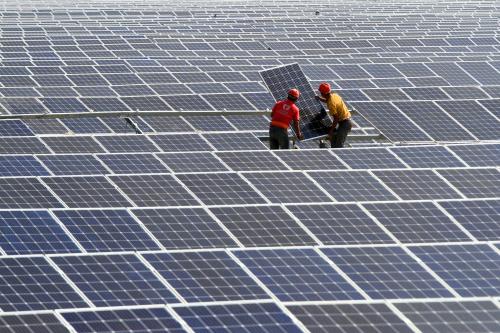Content from the Brookings Institution India Center is now archived. After seven years of an impactful partnership, as of September 11, 2020, Brookings India is now the Centre for Social and Economic Progress, an independent public policy institution based in India.
In this India-U.S. Policy Memo, Vikram Singh Mehta emphasizes the importance of energy as a solid pillar for building and consolidating India-U.S. relations and identifies three ways in which the two countries can cooperate further.
Energy should be a solid pillar upon which to build and consolidate India-U.S. relations. Both countries have a common interest in weakening the nexus between economic growth, energy demand, and environmental degradation. Both countries have concerns about energy supply and energy security. And both countries have to wrestle with the politics of walking the tightrope between enabling the market and regulating the sector. The governments should cement these commonalities through forums that facilitate exchange of information, technology, regulatory experience, and policy implementation. These forums should bring together government officials, regulators, and domain experts.
The U.S. has a strategic interest in geopolitical stability and a stable global oil market. It has wrought a “shale revolution” though entrepreneurship and innovation. It has been at the cutting edge of clean energy technology. India, too, has an abiding interest in the freedom of movement of oil and gas, especially through the choke points in the Middle East. It needs to bridge the gap between surging energy demand and scarce supplies. And it must harness clean energy technology to manage the environment.
Three subjects should be on the agenda of an initial conversation on the specifics of an exchange.
First, the U.S. Energy Independence and Security Act of 2007: This act laid out the road map for the U.S. to achieve energy independence, energy security, and energy sustainability. It also defined the metrics for measuring progress. India needs a similar road map. It should also consider legislation—the “Energy Responsibility and Security Act.” The context is markedly different in the two countries, but India could benefit by drawing on the U.S. experience to understand better the effectiveness of such legislation in coalescing public effort behind the objective of energy independence.
Second, the role of the government in developing new energy technology: The U.S. government has been a major contributor to energy innovation. The independent wildcatter George Mitchell has, for instance, been credited with the “shale revolution.” What is overlooked is the financial support he received from the U.S. government for nearly a decade. Another example is solar, which is fast becoming competitive against fossil fuels as an energy source. McKinsey & Co. has calculated that the cost of installed solar power in the U.S. has dropped from $6 per watt in 2010 to $2.60 per watt today and it estimates that it will come down to $1.30 per watt by 2020. If these projections bear out, then solar will soon give natural gas a serious run for the energy market. This steep cost reduction has only been possible because of the fiscal credits and the research grants provided by the government to universities, laboratories and companies. The Indian government has not been comparably supportive. It did set up a “clean energy” fund in 2000 but the bulk of those funds have not been disbursed. Instead it was sequestered by the Finance Ministry to ease the fiscal strain. Prime Minister Modi has talked of a “saffron revolution,” stressing the importance of solar energy and Finance Minister Jaitley in his budget speech has announced a doubling of the revenues going into the clean energy fund. This suggests that the government intends to move clean energy up on its policy agenda. It may therefore be an opportune moment to create an inter-government energy forum for joint research and development (R&D) and technology transfer.
Third, the contours of energy collaboration between the American and Indian defense establishments. The Pentagon is the single largest consumer of fuel in the U.S. Its agencies use about 90 million barrels of oil at a cost of approximately $15 billion every year. Energy efficiency is a core focus area and it has allocated $9 billion over the next five years for R&D on fuel efficiency, new blends, storage systems, electricity distribution, materials, etc. The Indian defense establishment is huge and it, too, has a compelling reason for pushing fuel efficiency and conservation. This mutuality of interest offers a peg on which to define the nature and extent of possible collaboration between the two establishments.
There are, of course, other subjects that could be on the agenda. Three such subjects: the export of liquefied natural gas from the U.S. to non-free trade agreement countries like India; the geopolitical, geoeconomic, and financial dynamics of international gas pipelines (Iran-Pakistan-India; Turkmenistan-Afghanistan-Pakistan-India; Russia-China); and maritime security. But, if time were limited then the three subjects outlined in more detail above should be the focus.


Commentary
Op-edEnergy: A Solid Pillar upon which to Build India-U.S. Relations
September 23, 2014